Acura RDX 2020 User Manual

Owner's Manuals at: owners.acura.com (U.S.) acura.ca (Canada)
Owner’s Guide
for Quick Reference
2020 RDX
31TJBG10 |
2020 Acura RDX Owner’s Guide |
|
OG10236 |
|
|
00X31-TJB-G100 |
© 2019 Honda Motor Co., Ltd. — All Rights Reserved |
Printed in U.S.A. |
DISCLOSURES
Devices That Emit Radio Waves
Each radio frequency device installed in the vehicle conforms to the requirements and standards of the regulation listed below:
As required by the FCC:
This device complies with Part 15 of the FCC rules. Operation is subject to the following two conditions: (1) This device may not cause harmful interference, and (2) this device must accept any interference received, including interference that may cause undesired operation.
Changes or modifications not expressly approved by the party responsible for compliance could void the user’s authority to operate the equipment.
As required by Industry Canada:
This device complies with Industry Canada licence-exempt RSS standard(s). Operation is subject to the following two conditions: (1) this device may not cause interference, and (2) this device must accept any interference, including interference that may cause undesired operation of the device.
Disclaimer
The information and data contained herein are believed to be accurate and reliable. American Honda Motor Co., Inc. makes no warranty of any kind and accepts no responsibility for the results obtained through application of this information.
Privacy Notice
This vehicle may share location and usage information. To manage this setting, visit www.acuralink.com/vehicle-data-choices.
Event Data Recorders
This vehicle is equipped with an event data recorder (EDR). The main purpose of an EDR is to record, in certain crash or near crash-like situations, such as an airbag deployment or hitting a road obstacle, data that will assist in understanding how a vehicle’s systems performed. The EDR is designed to record data related to vehicle dynamics and safety systems for a short period of time, typically 30 seconds or less. The EDR in this vehicle is designed to record such data as:
•How various systems in your vehicle were operating;
•Whether or not the driver and passenger safety belts were buckled/ fastened;
•How far (if at all) the driver was depressing the accelerator and/or brake pedal; and,
•How fast the vehicle was traveling.
These data can help provide a better understanding of the circumstances in which crashes and injuries occur. NOTE: EDR data are recorded by your vehicle only if a non-trivial crash situation occurs; no data are recorded by the EDR under normal driving conditions and no personal data (e.g., name, gender, age, and crash location) are recorded. However, other parties, such as law enforcement, could combine the EDR data with the type of personally identifying data routinely acquired during a crash investigation.
To read data recorded by an EDR, special equipment is required, and access to the vehicle or the EDR is needed. In addition to the vehicle manufacturer, other parties such as law enforcement that have the special equipment can read the information if they have access to the vehicle or the EDR.
The data belong to the vehicle owner and may not be accessed by anyone else except as legally required or with the permission of the vehicle owner.
Service Diagnostic Recorders
This vehicle is equipped with service-related devices that record information about powertrain performance. The data can be used to verify emissions law requirements and/or help technicians diagnose and solve service problems. It may also be combined with data from other sources for research purposes, but it remains confidential. Some diagnostic and maintenance information is uploaded to Acura upon vehicle start up.
INTRODUCTION
This Owner's Guide is intended to help you quickly get acquainted with your 2020 RDX. It provides basic information and instructions on technology and convenience features, as well as emergency procedures and how to get assistance.
This guide is for vehicles sold in the United States and Canada. It covers all variations of your model, so you may find descriptions of features and equipment that are not in your vehicle. Images throughout this guide represent features and equipment that are available on some, but not all, models.
This guide is not intended to be a substitute for the Owner's Manual. Visit owners.acura.com (U.S.) or acura.ca (Canada) to view the most current Owner's Manual, Navigation Manual, Vehicle Warranty, and the tire manufactures' warranties.
If you are the first registered owner of your vehicle, you may request a complimentary printed copy of the Owner's Manual, Navigation Manual, or Vehicle Warranty within the first six months of vehicle purchase. To request a copy, visit owners.acura.com and create or log in to your account. In Canada, please request a copy from your Acura dealer.
American Honda Motor Co., Inc. strives to be proactive in protecting our environment and natural resources. By using electronic delivery for a considerable portion of the information typically found in a vehicle Owner's Manual, we are further reducing our impact on the environment.
Acura Client Relations
Your authorized Acura dealer should be able to answer any questions you have about your vehicle. However, if you are dissatisfied with the information you receive, you can call Acura Client Relations.
Call (800) 382-2238 (U.S.) or (888) 922-8729 (Canada)
Acura Total Luxury Care Roadside Assistance
Your Acura TLC Roadside Assistance representative is here to help you 24 hours a day, 7 days a week. Under your 4-year/50,000-mile (80,000-km) warranty, the following benefits are available:
•Towing services — full cost of towing to the closest Acura dealer
•Roadside assistance — jump starting, fuel delivery, lockout, and flat tire
•Trip planning — detailed trip routing, emergency services, and more
Call (800) 594-8500 (U.S.) or (800) 565-7587 (Canada)
TABLE OF CONTENTS
VISUAL INDEX.................................... |
1 |
NAVIGATION................................... |
81 |
|
SAFETY INFORMATION................... |
3 |
DRIVING........................................... |
84 |
|
INSTRUMENT PANEL..................... |
26 |
HANDLING THE UNEXPECTED... |
116 |
|
VEHICLE CONTROLS...................... |
31 |
MAINTENANCE............................. |
132 |
|
AUDIO AND CONNECTIVITY....... |
57 |
SPECIFICATIONS........................... |
153 |
|
BLUETOOTH® HANDSFREELINK ® |
CLIENT INFORMATION................ |
155 |
||
....................................................... |
74 |
INDEX |
157 |
|
VOICE COMMAND INDEX |
80 |
|||
|
|
|||
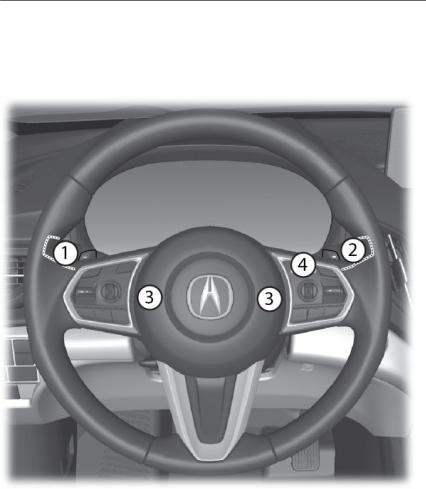
VISUAL INDEX
VISUAL INDEX
Locate items in the vehicle's interior.
Steering Wheel and Nearby Controls
This page intentionally left blank.
1. |
Lights/Turn Signals |
3. |
Horn |
2. |
Wipers/Washers |
4. |
Brightness Control |
| 1
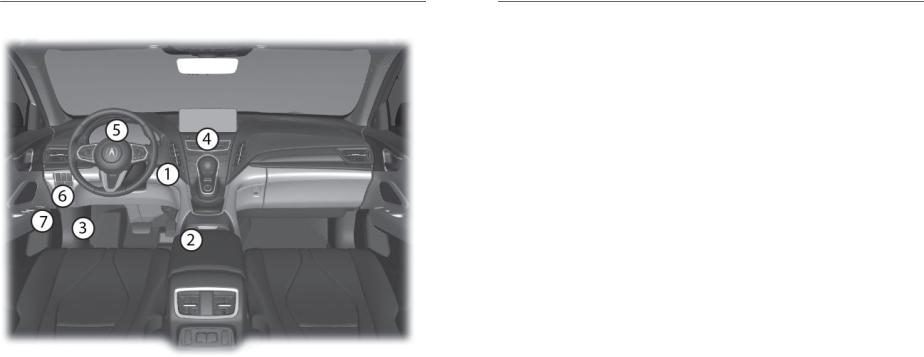
VISUAL INDEX
Dashboard and Nearby Controls
1. |
ENGINE START/STOP Button |
5. |
Multi-Information Display |
2. |
USB Port |
6. |
Parking Brake |
3. |
Hood Release Handle |
7. |
Power Tailgate Button *1 |
4. |
Hazard Warning Button |
|
|
*1 - If equipped
SAFETY INFORMATION
SAFETY INFORMATION
Your safety, and the safety of others, is very important and operating this vehicle safely is an important responsibility. While we strive to help you make informed decisions about safety, it is not practical or possible to warn you about all the hazards associated with operating or maintaining your vehicle. Therefore, you must use your own good judgment.
Important Safety Information
This guide explains many of your vehicle's safety features and how to use them. Please read this information carefully. Following the instructions below will also help to keep you and your passengers safe.
nImportant Safety Precautions
•Always wear your seat belt.
•Secure all children in the proper restraint system.
•Be aware of airbag hazards.
•Don't drink and drive.
•Pay appropriate attention to the task of driving safely.
•Control your speed.
•Keep your vehicle in safe condition.
Engaging in cell phone conversation or other activities that keep you from paying close attention to the road, other vehicles, and pedestrians could lead to a crash. Remember, situations can change quickly, and only you can decide when it is safe to divert some attention away from driving.
nImportant Handling Information
Your vehicle has higher ground clearance than a passenger vehicle designed for use only on pavement. Higher ground clearance has many advantages for off-highway driving. It allows you to travel over bumps, obstacles, and rough terrain. It also provides good visibility so you can anticipate problems earlier. These advantages come at some cost. Because your vehicle is taller and rides higher off the ground, it has a higher center gravity making it more susceptible to tipping or roll over if you make abrupt turns. Utility vehicles have a significantly higher rollover rate than other types of vehicles. In a rollover crash, an unbelted person is significantly more likely to die than a person wearing a seat belt. As a reminder, make sure you and your passengers always wear seat belts.
2 | |
| 3 |

SAFETY INFORMATION
n Safety Messages
When you see the following messages throughout this guide, pay close attention.
You WILL be KILLED or SERIOUSLY HURT if you don’t follow instructions.
You CAN be KILLED or SERIOUSLY HURT if you don’t follow instructions.
You CAN be HURT if you don’t follow instructions.
This information is intended to help you avoid damage to your vehicle, other property, or the environment.
nCarbon Monoxide Gas
The engine exhaust from this vehicle contains carbon monoxide, a colorless, odorless, and highly toxic gas. As long as you properly maintain your vehicle and follow the instructions set forth below, you will not accumulate dangerous levels of carbon monoxide gas in the vehicle interior.
Have the exhaust system inspected for leaks whenever:
•The exhaust system is making an unusual noise.
•The exhaust system may have been damaged.
•The vehicle is raised for an oil change.
When you operate a vehicle with the tailgate open, airflow can pull exhaust gas into the interior and create a hazardous condition. If you must drive with the tailgate open, open all the windows and set the climate control system as shown below:
1.Select the fresh air mode.
2.Select the  mode.
mode.
3.Set the fan speed to high.
4.Set the temperature control to a comfortable setting.
4 |
SAFETY INFORMATION
Adjust the climate control system in the same manner if you sit in your parked vehicle with the engine running.
Carbon monoxide gas is toxic.
Breathing it can cause unconsciousness and even kill you.
Avoid any enclosed areas or activities that expose you to carbon monoxide.
An enclosed area such as a garage can quickly fill up with carbon monoxide gas. Do not run the engine with the garage door closed. Even when the garage door is open, drive out of the garage immediately after starting the engine.
Seat Belts
A seat belt is your best protection in all types of collisions. Airbags are designed to supplement seat belts, not replace them. So even though your vehicle is equipped with airbags, make sure you and your passengers always wear your seat belts and wear them properly.
nLap/Shoulder Seat Belts
All five seating positions are equipped with lap/shoulder seat belts with emergency locking retractors. In normal driving, the retractor lets you move freely while keeping some tension on the belt. During a collision or sudden stop, the retractor locks to restrain your body. The rear seat belts also have a lockable retractor for use with child seats.
The front seats are equipped with automatic seat belt tensioners to enhance safety. The tensioners automatically tighten the front seat belts during a moderate to severe frontal collision, sometimes even if the collision is not severe enough to inflate the front airbags.
nProper Use of Seat Belts
Follow these guidelines for proper use:
•All occupants should sit upright, well back in the seat, and remain in the position for the duration of the trip. Slouching and leaning reduces the effectiveness of the belt and can increase the chance of serious injury in a crash.
•Never place the shoulder part of a lap/shoulder seat belt under your arm or behind your back. This could cause very serious injuries in a crash.
•Two people should never use the same seat belt. If they do, they could be very seriously injured in a crash.
| 5
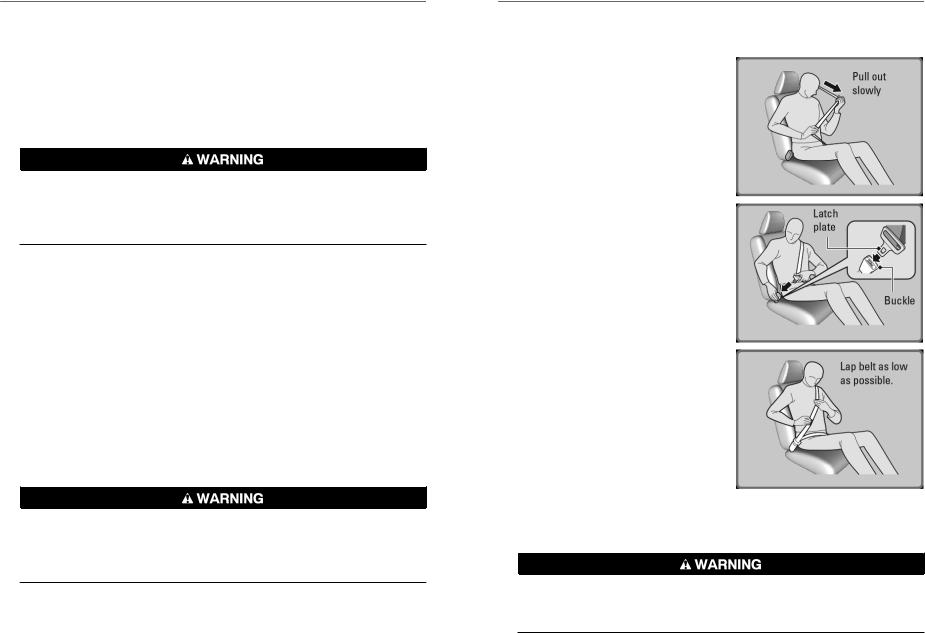
SAFETY INFORMATION
•Do not put any accessories on the seat belts. Devices intended to improve comfort or reposition the shoulder part of a seat belt can reduce the protective capability and increase the chance of serious injury in a crash.
•No one should sit in a seat with an inoperative seat belt or one that does not appear to be working correctly. Using a seat belt that is not working properly may not protect the occupant in a crash. Have a dealer check the belt as soon as possible.
Not wearing a seat belt properly increases the chance of a serious injury or death in a crash, even though your vehicle has airbags.
Be sure you and your passengers always wear seat belts and wear them properly.
nSeat Belt Inspection
Regularly check the condition of your seat belts as follows:
•Pull each belt out fully and look for frays, cuts, burns, and wear.
•Check that the latch plates and buckles work smoothly and the belts retract easily. If a belt does not retract easily, cleaning the belt may correct the problem. Only use mild soap and warm water. Do not use bleach or cleaning solvents. Make sure the belt is completely dry before allowing it to retract.
Any belt that is not in good condition or working properly will not provide proper protection and should be replaced as soon as possible.
A belt that has been worn during a crash may not provide the same level of protection in a subsequent crash. Have your seat belts inspected by a dealer after any collision.
Not checking or maintaining seat belts can result in serious injury or death if the seat belts do not work properly when needed.
Check your seat belts regularly and have any problem corrected as soon as possible.
SAFETY INFORMATION
nFastening a Seat Belt
Adjust your seat to the proper position and then follow the steps below: 1. Pull the seat belt out slowly.
2.Insert the latch plate into the buckle, then tug on the belt to make sure the buckle is secure. Make sure that the belt is not twisted or caught on anything.
3.Position the lap part of the belt as low as possible across your hips, then pull up on the shoulder part of the belt so the lap part fits snugly. This lets your strong pelvic bones take the force of a crash and reduces the chance of internal injuries.
4.If necessary, pull up on the belt again to remove any slack, then make sure that the belt rests across the center of your chest and over your shoulder. This spreads the
forces of a crash over the strongest bones in your upper body.
To release the belt, push the red PRESS button then guide the belt by hand until it has retracted completely.
Improperly positioning the seat belt can cause serious injury or death in a crash.
Make sure all seat belts are properly positioned before driving.
6 | |
| 7 |

SAFETY INFORMATION
nAdjusting the Shoulder Anchor
The front seats have adjustable shoulder anchors to accommodate taller and shorter occupants.
1.Move the anchor up and down while holding the release button.
2.Position the anchor so that the belt rests across the center of your chest and over your shoulder.
Airbags
Your vehicle is equipped with several types of airbags: front airbags, front knee airbags, side airbags, and side curtain airbags.
nFront Airbags (SRS)
The front SRS airbags inflate in a moderate-to-severe frontal collision to help protect the head and chest of the driver and/or front passenger. They are housed in the center of the steering wheel for the driver and in the dashboard for the front passenger. Both airbags are marked SRS AIRBAG.
SRS (Supplemental Restraint System) indicates that the airbags are designed to supplement seat belts, not replace them. Seat belts are the occupant's primary restraint system.
Front Knee Airbags
The knee SRS airbags inflate in a moderate-to-severe front collision to help keep the driver and/or front passenger in the proper position and to help maximize the benefit provided by the vehicle's other safety features.
SAFETY INFORMATION
nAdvanced Airbags
The airbags have advanced features to help reduce the likelihood of airbag related injuries to smaller occupants.
The driver's advanced airbag system includes a seat position sensor. Based on information from this sensor and the severity of the impact, the advanced airbag system determines the optimal deployment of the driver's airbag.
The front passenger's advanced airbag system has weight sensors.
We advise against allowing a child age 12 or under to ride in the front passenger's seat. However, if you do allow a child age 12 or under to ride in the front passenger's seat, note that the system will automatically turn off the front passenger's airbag if the sensors detect that the child is approximately 65 lbs (29 kg) or less.
For the advanced airbags to work properly:
•Do not spill any liquid on or under the seats.
•Do not put any object under the passenger's seat.
•Make sure any objects are positioned properly on the floor. Improperly positioned objects can interfere with the advanced airbag sensors.
•All occupants should sit upright and wear their seat belts properly.
•Do not cover the passenger's side dashboard with a cloth, towel, cover, etc.
•Make sure the floor mat behind the front passenger's seat is hooked to the floor mat anchor. An improperly placed mat can interfere with the advanced airbag sensors.
8 | |
| 9 |
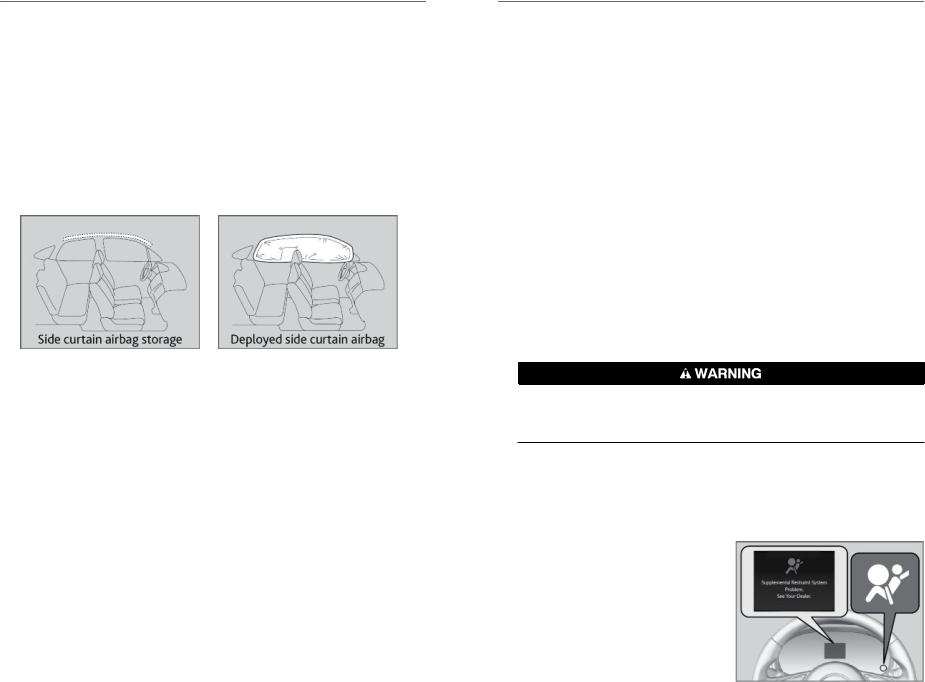
SAFETY INFORMATION
nSide Airbags
The side airbags help protect the upper torso and pelvis of the driver or a front passenger during a moderate-to-severe side impact. They are housed in the outside edge of the driver's and front passenger's seat-backs. Both are marked SIDE AIRBAG.
nSide Curtain Airbags
Side curtain airbags help protect the heads of the driver and passengers in outer seating positions during a moderate-to-severe side impact. The side curtain airbags equipped in this vehicle are also designed to help reduce the likelihood of partial and complete ejection of vehicle occupants through side windows in crashes, particularly rollover crashes.
The side curtain airbags are located in the ceiling above the side windows on both sides of the vehicle.
The side curtain airbags are deigned to deploy in a rollover or moderate- to-severe side impact. If the SRS control unit senses that your vehicles is about to roll over, it immediately deploys both side curtain airbags and activates both front seat belt tensioners. If the impact is on the passenger's side, the passenger's side curtain airbag will inflate even if there are no occupants on that side of the vehicle.
To get the best protection from the side curtain airbags, occupants should wear their seat belts properly and sit upright and well back in their seats.
Do not attach any objects to the side windows or roof pillars, as they can interfere with the proper operation of the side curtain airbags.
When side curtain airbags deploy in a frontal collision
One or both side curtain airbags may inflate in a moderate-to-severe angled frontal collision.
SAFETY INFORMATION
nImportant Facts About Your Airbags
Always wear your seat belt properly, sit upright, and as far back from the steering wheel as possible while allowing full control of the vehicle. A front passenger should move their seat as far back from the dashboard as possible.
Do not place hard or sharp objects between yourself and a front airbag.
Carrying hard or sharp objects on your lap, or driving with a pipe or other sharp object in your mouth, can result in injuries if your front airbag inflates.
Do not attach or place objects on the front airbag covers. Objects on the covers marked SRS AIRBAG could interfere with the proper operation of the airbags or be propelled inside the vehicle and hurt someone if the airbags inflate.
Do not attach accessories on or near the side airbags. They can interfere with the proper operation of the airbags or hurt someone if an airbag inflates.
Do not attach any objects to the side windows or roof pillars. They can interfere with the proper operation of the side curtain airbags.
Do not cover or replace the front seat-back covers. This can prevent your side airbags from properly deploying during a side impact.
An open glove box can cause serious injury to your passenger in a crash, even if the passenger is wearing the seat belt.
Always keep the glove box closed while driving.
nAirbag System Indicators
If a problem occurs in the airbag system, the SRS indicator comes on and a message appears on the Multi-Information Display.
Supplemental Restraint System (SRS) Indicator
If the indicator comes on at any other time besides vehicle start-up or does not come on at all, have the system checked by a dealer as soon as possible. If you don't, your airbags and seat belt tensioners may not work properly when they are needed.
10 | |
| 11 |
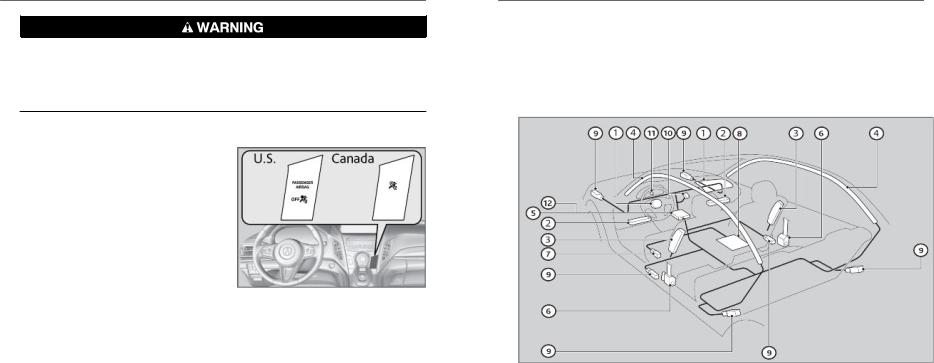
SAFETY INFORMATION
Ignoring the SRS indicator can result in serious injury or death if the airbag systems or tensioners do not work properly.
Have your vehicle checked by a dealer as soon as possible if the SRS indicator alerts you to a possible problem.
Passenger Airbag Off Indicator
The indicator comes on to alert you that the front passenger’s front airbag has been turned off. This occurs when the front passenger’s weight sensors detect 65 lbs (29 kg) or less, the weight of an infant or small child, on the seat.
Infants and small children should always ride properly restrained in a back seat.
If the front passenger‘s seat is empty, the indicator will come on and, in the event of a crash, the front passenger's airbag will not deploy. The front passenger's knee airbag will not deploy either.
To ensure the passenger is detected properly, confirm that:
•There is no child seat or other object pressing against the rear of the seat-back.
•There is no rear passenger pushing or pulling on the back of the front passenger's seat.
•The front seat or seat-back is not forced back against an object on the seat or floor behind it.
•There is no object placed under or beside the front passenger's seat.
•The occupant is sitting in an upright position and the seat-back is not excessively reclined.
•The occupant is not leaning against the door or center console.
•The occupant's feet are placed on the floor in front of them.
•There are no objects hanging from the front passenger's seat.
•Only small, lightweight objects are in the seat-back pocket.
Have your vehicle checked by a dealer as soon as possible if:
•All of the above conditions are met and the indicator comes on with an adult seated in the front passenger seat.
12 |
SAFETY INFORMATION
• The seat is empty and the indicator is off
The passenger airbag off indicator may come on and go off repeatedly if the total weight on the seat is near the airbag cutoff threshold.
Do not allow a passenger to ride in the front seat when the indicator is on.
n Airbag System Components
1.Two SRS (Supplemental Restraint System) front airbags. The driver’s airbag is stored in the center of the steering wheel; the front passenger’s airbag is stored in the dashboard. Both are marked SRS AIRBAG.
2.Two front knee airbags. The driver's knee airbag is stored under the steering column; the front passenger's knee airbag is stored under the glove box. Both are marked SRS AIRBAG.
3.Two side airbags, one for the driver and one for a front passenger. The airbags are stored in the outer edges of the seat-backs. Both are marked SIDE AIRBAG.
4.Two side curtain airbags, one for each side of the vehicle. The airbags are stored in the ceiling, above the side windows. The front and rear pillars are marked SIDE CURTAIN AIRBAG.
5.An electronic control unit that, when the power mode is in ON, continually monitors information about the various impact sensors, seat and buckle sensors, rollover sensor, airbag activators, seat belt tensioners, and other vehicle information. During a crash event the unit can record such information.
| 13

SAFETY INFORMATION
6.Automatic front seat belt tensioners. The driver’s and front passenger’s seat belt buckles incorporate sensors that detect whether or not the belts are fastened.
7.A driver’s seat position sensor. This sensor determines the optimal force at which the airbag will deploy in a crash.
8.Weight sensors in the front passenger’s seat. The front passenger’s airbag will be turned off if the weight on the seat is about 65 lbs (29 kg) or less (the weight of an infant or small child).
9.Impact sensors that can detect a moderate-to-severe front or side impact.
10.An indicator on the dashboard that alerts you that the front passenger’s front airbag has been turned off.
11.An indicator on the instrument panel that alerts you to a possible problem with the airbag system or seat belt tensioners.
12.A rollover sensor that can detect if your vehicle is about to roll over and signal the control unit to deploy both side curtain airbags.
nAirbag Care
You do not need to, and should not, perform any maintenance on or replace any airbag system components yourself. However, you should have your vehicle inspected by a dealer in the following situations:
When the airbags have deployed
If an airbag has inflated, the control unit and other related parts must be replaced. Similarly, once an automatic seat belt tensioner has been activated, it must be replaced.
When the vehicle has been in a moderate-to-severe collision
Even if the airbags did not inflate, have your dealer inspect the following: the driver’s seat position sensor, weight sensors in the passenger’s seat, front seat belt tensioners, and each seat belt that was worn during the crash.
Do not remove or modify a front seat without first consulting a dealer
This would likely disable or affect the driver’s seat position sensor or the weight sensors in the passenger’s seat. If it is necessary to remove or modify a front seat to accommodate a person with disabilities, contact an Acura dealer. For U.S. vehicles, call Acura Client Relations at (800) 382-2238. For Canadian vehicles, call Acura Client Services at (888) 922-8729.
14 |
SAFETY INFORMATION
Child Safety
Each year, many children are injured or killed in vehicle crashes because they are either unrestrained or not properly restrained. In fact, vehicle collisions are the number one cause of death of children ages 12 and under.
The National Highway Traffic Safety Administration and Transport Canada recommend that all children ages 12 and under be properly restrained in a rear seat. Some states or provinces/territories have laws restricting where children may ride.
To reduce the number of child deaths and injuries, every state, Canadian province, and territory requires that infants and children be properly restrained when they ride in a vehicle.
nProtecting Child Passengers – Important Considerations
•An inflating front or side airbag can injure or kill a child sitting in the front seat.
•A child in the front seat is more likely to interfere with the driver's ability to safely control the vehicle.
•Statistics show that children of all sizes and ages are safer when they are properly restrained in a rear seat.
•Any child who is too small to wear a seat belt correctly must be restrained in an approved child seat that is properly secured to the vehicle using either the lap belt portion of the lap/shoulder belt or the lower anchors of the LATCH system.
•Never hold a child on your lap because it is impossible to protect them in the event of a collision.
•Never put a seat belt over yourself and a child. During a crash, the belt would likely press deep into the child and cause serious or fatal injuries.
•Never let two children use the same seat belt. Both children could be very seriously injured in a crash.
•Do not allow children to operate the doors, windows, or seat adjustments.
| 15
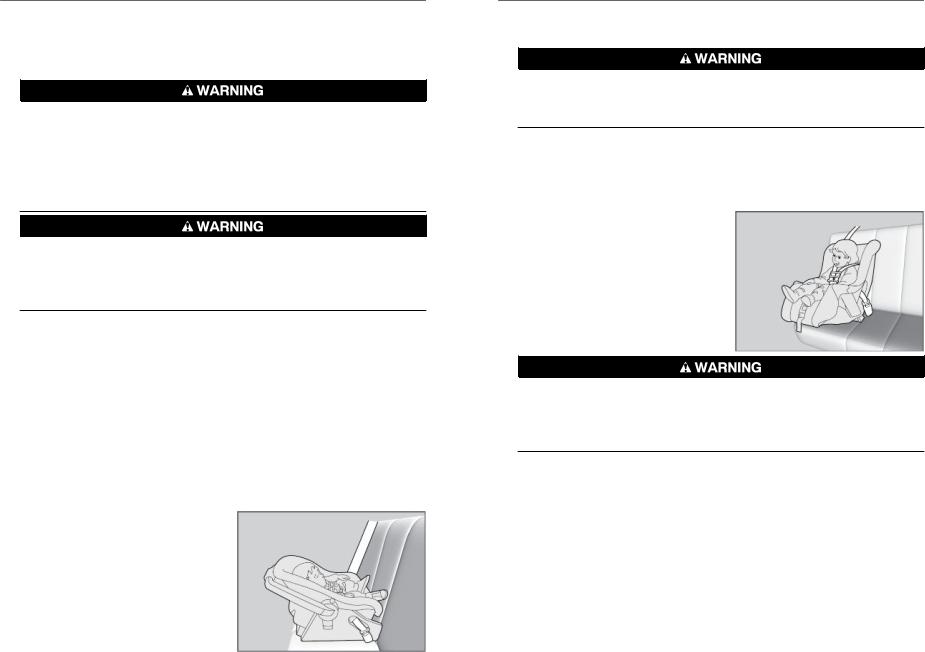
SAFETY INFORMATION
•Do not leave children, pets or people needing assistance in the vehicle unattended, especially in hot weather when the inside of the vehicle can get hot enough to kill them. They could also activate vehicle controls, causing it to move unexpectedly.
Children who are unrestrained or improperly restrained can be seriously injured or killed in a crash.
Any child too small for a seat belt should be properly restrained in a child seat.
A larger child should be properly restrained with a seat belt, using a booster seat if necessary.
Allowing a child to play with a seat belt or wrap one around their neck can result in serious injury or death.
Instruct children not to play with any seat belt and make sure any unused seat belt a child can reach is buckled, fully retracted, and locked.
nProtecting Infants
An infant must be properly restrained in a rear-facing, reclining child seat until the infant reaches the seat maker’s weight or height limit for the seat, and the infant is at least one year old. Many experts recommend use of a rear-facing seat for a child up to two years old if the child’s height and weight are appropriate for a rear-facing seat.
Child seats must be placed and secured in a rear seating position. Rearfacing child seats should never be installed in a forward-facing position. When properly installed, a rear-facing child seat may prevent the driver or a front passenger from moving their seat all the way back, or from locking their seat-back in the desired position.
Make sure that there is no contact between the child seat and the seat in front of it. It can also interfere with proper operation of the front passenger’s advanced front airbag system. If this occurs, we recommend that you install the child seat directly behind the front passenger’s seat, move the seat as far forward as
16 |
SAFETY INFORMATION
needed, and leave it unoccupied. Or, you may wish to get a smaller rearfacing child seat.
Placing a rear-facing child seat in the front seat can result in serious injury or death during a crash.
Always place a rear-facing child seat in the rear seat, not the front.
nProtecting Smaller Children
If a child is at least one year old and within the weight range indicated by the child seat manufacturer, the child should be properly restrained in a firmly secured forward-facing child seat.
We strongly recommend placing a forward-facing child seat in a rear seating position. Placing a forwardfacing child seat in the front seat can be hazardous, even with advanced front airbags that automatically turn the passenger’s front airbag off. A rear seat is the safest place for a child.
Placing a forward-facing child seat in the front seat can result in serious injury or death if the front airbag inflates.
If you must place a forward-facing child seat in front, move the vehicle seat as far back as possible, and properly restrain the child.
nSelecting a Child Seat
Most child seats are LATCH-compatible (Lower Anchors and Tethers for CHildren). Some have a rigid-type connector, while others have a flexibletype connector. Both are equally easy to use. Some existing and previously owned child seats can only be installed using the seat belt. Whichever type you choose, follow the child seat manufacturer’s use and care instructions as well as the instructions in this guide. Proper installation is key to maximizing your child’s safety.
In seating positions and vehicles not equipped with LATCH, a LATCH compatible child seat can be installed using the seat belt and a top tether for added security. This is because all child seats are required to be designed so that they can be secured with a lap belt or the lap part of a lap/shoulder belt. In addition, the child seat manufacturer may advise that a seat belt be used to attach a LATCH-compatible seat once a child
| 17
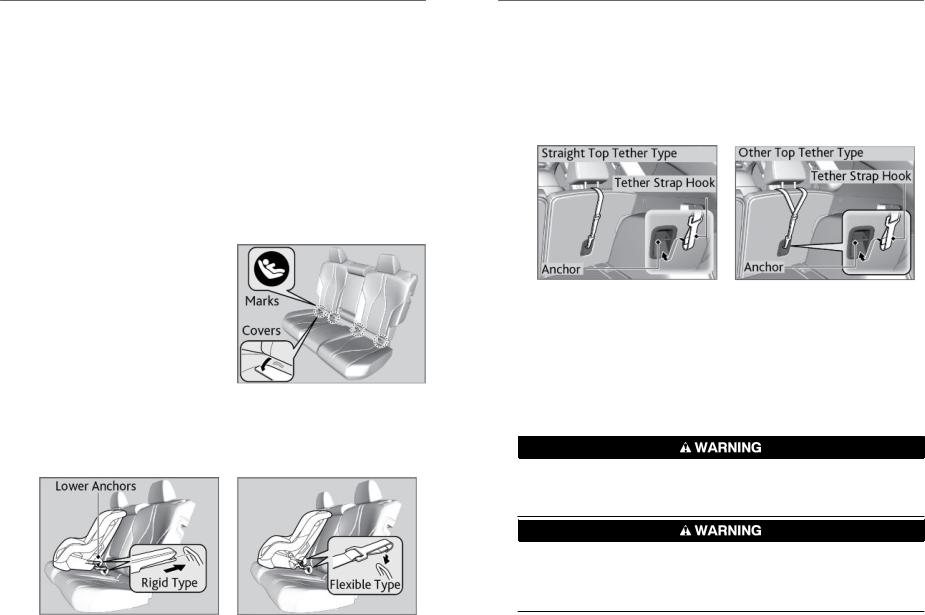
SAFETY INFORMATION
reaches a specified weight. Please read the child seat owner’s manual for proper installation instructions.
Important considerations when selecting a child seat
Make sure the child seat meets the following three requirements:
•The child seat is the correct type and size for the child.
•The child seat is the correct type for the seating position.
•The child seat is compliant with Federal Motor Vehicle Safety Standard 213 or Canadian Motor Vehicle Safety Standard 213.
nInstalling a LATCH-Compatible Child Seat
A LATCH-compatible child seat can be installed in either of the two outer rear seats. A child seat is attached to the lower anchors with either the rigid or flexible type of connectors.
1.Locate the anchor marks affixed to the base of the seat cushion. Make sure there are no objects near the anchors that could prevent a secure connection between the child seat and the anchors.
2.Lower anchors are located inside the seat cushion below the marks.
3.Place the child seat on the vehicle seat, then attach the child seat to the lower anchors according to the instructions that came with the child seat. Make sure that the lower anchors are not obstructed by the seat belt or any other object.
SAFETY INFORMATION
4.Seats in the outer positions (straight top tether type): Put the head restraint to its highest position. Route the tether strap between the head restraint legs and secure the tether strap hook to the anchor. Make sure the strap is not twisted.
Seats in the outer positions (other top tether type): Put the head restraint to its highest position. Route the tether strap outside the head restraint legs and secure the tether strap hook to the anchor. Make sure the strap is not twisted.
5.Tighten the tether strap as instructed by the child seat manufacturer.
6.Make sure the child seat is firmly secured by rocking it forward and back and side to side; little movement should be felt.
7.Make sure any unused seat belt that a child can reach is buckled, the lockable retractor is activated, and the belt is fully retracted and locked.
To deactivate a lockable retractor, release the buckle and allow the seat belt to wind up all the way.
Never attach two child seats to the same anchor.
In a collision, one anchor may not be strong enough to hold two child seats attachments and may break, causing serious injury or death.
Do not use the lower inner anchors of the outer rear seats to secure a LATCH-compatible child seat to the rear center seat, unless the child seat manufacturer's instructions for that system permit the use of inner anchors with the stated spacing.
18 | |
| 19 |
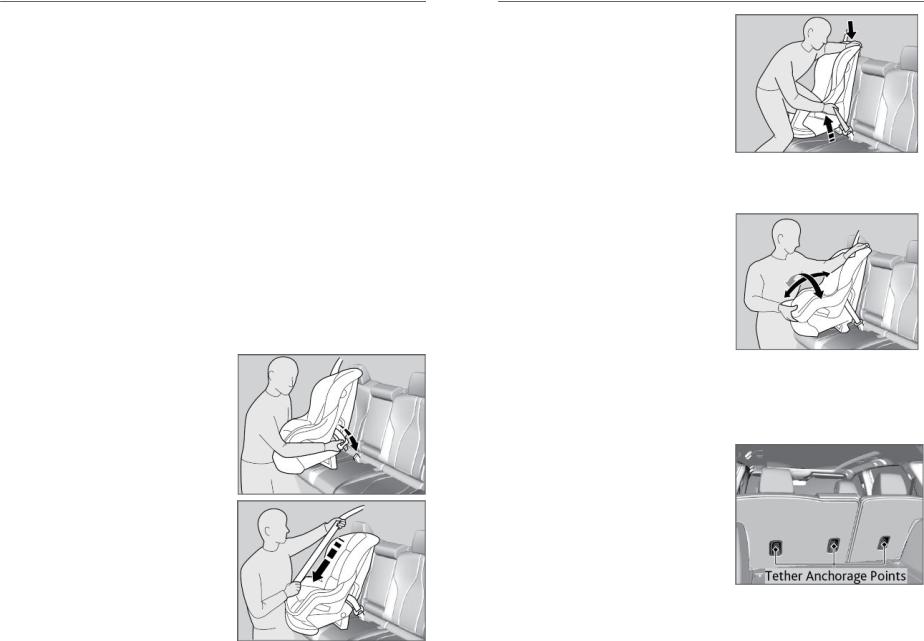
SAFETY INFORMATION
Installing a LATCH-compatible child seat in the rear center seat
Each outer rear seat is equipped with a pair of lower anchors which are used to secure a LATCH-compatible child seat. The rear center seat, however, is not equipped with anchors of any kind.
The inner and outer anchors are spaced apart at a standard distance of 11 inches (280 mm).
The distance between the two inner anchors is:
• 16.3 inches (415 mm)
LATCH-compatible restraint systems that are fitted with rigid-type attachments cannot be installed in the rear center seat. However, a system fitted with flexible-type attachments can be installed in the center seat, provided that the child seat manufacturer’s instructions for that system permit the use of the inner anchors with the stated spacing.
Before seating a child, make sure that the system is properly attached to both the lower anchors and tether anchors.
nInstalling a Child Seat with a Lap/Shoulder Seat Belt
A child seat can be installed with a lap/shoulder belt in any rear seat or, if absolutely necessary, the front passenger seat.
1.Place the child seat on the vehicle seat.
2.Route the seat belt through the child seat according to the seat manufacturer’s instructions, and insert the latch plate into the buckle. Insert the latch plate fully until it clicks.
3.Slowly pull the shoulder part of the belt all the way out until it stops. This activates the lockable retractor.
SAFETY INFORMATION
4.Let the seat belt completely wind up into the retractor, then try to pull it out to make sure the retractor is locked. If you are able to pull the shoulder belt out, the lockable retractor is not activated. Pull the seat belt all the way out, and repeat steps 3 – 4.
5.Grab the shoulder part of the seat belt near the buckle, and pull up to
remove any slack from the lap part of the belt. When doing this, place your weight on the child seat and push it into the vehicle seat.
6.Make sure the child seat is firmly secured by rocking it forward and back and side to side; less than one inch of movement should occur near the seat belt.
7.Make sure any unused seat belt that a child can reach is buckled, the lockable retractor is activated, and the belt is fully retracted and locked.
To deactivate a lockable retractor, release the buckle and allow the seat belt to wind up all the way.
nAdding Security with a Tether
A tether anchorage point is provided behind each rear seating position. If you have a child seat that comes with a tether but can be installed with a seat belt, the tether may be used for additional security.
1. Locate the appropriate tether anchorage point.
20 | |
| 21 |
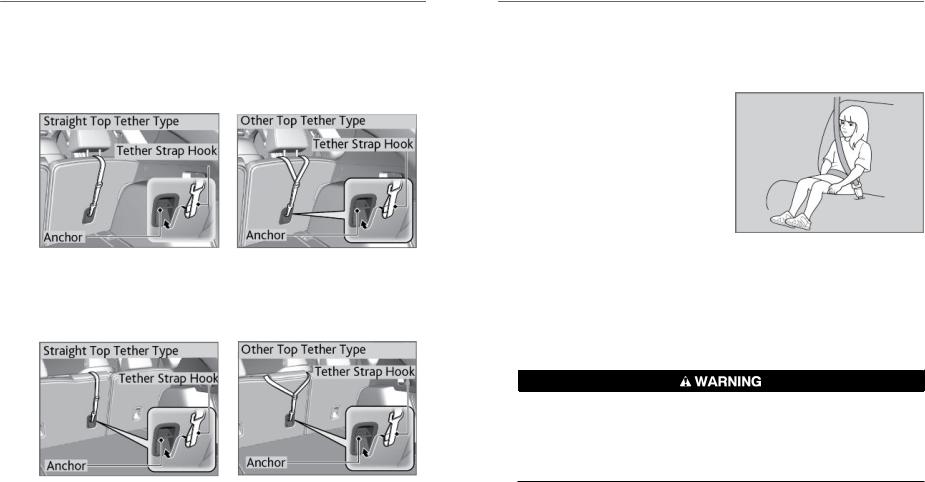
SAFETY INFORMATION
2.For the outer position: (straight top tether type) Raise the outer head restraint to its highest position, then route the tether strap between the head restraint legs.
For the outer position: (other top tether type) Raise the outer head restraint to its highest position, then route the tether strap outside the head restraint legs. Make sure the strap is not twisted.
For the center position: (straight top tether type) Lower the center head restraint to its lowest position, then route the tether strap over the head restraint.
For the center position: (other top tether type) Route the tether strap outside the head restraint. Make sure the strap is not twisted.
3.Secure the tether strap hook onto the anchor. Make sure the strap is not twisted.
4.Tighten the tether strap as instructed by the child seat manufacturer.
Note: Always use a tether for forward facing child seats when using the seat belt or lower anchors.
SAFETY INFORMATION
nProtecting Larger Children
When a child is too big for a child seat, secure the child in a rear seat using the lap/shoulder seat belt.
Have the child sit upright and all the way back, then ensure the following:
•The child’s knees bend comfortably over the edge of the seat.
•The shoulder belt crosses between the child’s neck and arm.
•The lap part of the seat belt is as low as possible, touching the child’s thighs.
•The child can stay seated for the whole trip.
If a lap/shoulder belt cannot be used properly, position the child in a booster seat in a rear seating position. For the child’s safety, check that the child meets the booster seat manufacturer’s recommendations.
Some U.S. states and Canadian provinces/territories require children to use a booster seat until they reach a given age or weight (e.g., 6 years or 60 lbs). Be sure to check current laws in the state or province/territory where you intend to drive.
Allowing a child age 12 or under to sit in the front can result in injury or death if the passenger’s front airbag inflates.
If a larger child must ride in front, move the vehicle seat as far to the rear as possible, have the child sit up properly and wear the seat belt properly, using a booster seat if needed.
22 | |
| 23 |

SAFETY INFORMATION
Safety Label Locations
Safety labels are in the locations shown. They warn you of potential hazards that can cause serious injury or death. Read these labels carefully.
If a label comes off or becomes hard to read (except for the U.S. dashboard label which may be removed by the owner), contact a dealer for a replacement.
SAFETY INFORMATION
Reporting Safety Defects
In the U.S.
If you believe that your vehicle has a defect which could cause a crash or could cause injury or death, you should immediately inform the National Highway Traffic Safety Administration (NHTSA) in addition to notifying American Honda Motor Co., Inc.
If NHTSA receives similar complaints, it may open an investigation, and if it finds that a safety defect exists in a group of vehicles, it may order a recall and remedy campaign. However, NHTSA cannot become involved in individual problems between you, your dealer, or American Honda Motor Co., Inc.
To contact NHTSA, you may call the Vehicle Safety Hotline toll-free at 1-888-327-4236 (TTY: 1-800-424-9153); go to safercar.gov, or write to: Administrator, NHTSA,1200 New Jersey Avenue, SE., Washington, DC 20590. You can also obtain other information about motor vehicle safety from safercar.gov.
In Canada
If you believe that your vehicle has a defect which could cause a crash or could cause injury or death, you should immediately inform Honda Canada, Inc., and you may also inform Transport Canada.
If Transport Canada receives similar complaints, it may open an investigation, and if it finds that a safety defect exists in a group of vehicles, it may lead to a recall and remedy campaign. However, Transport Canada cannot become involved in individual problems between you, your dealer, or Honda Canada, Inc.
To contact Transport Canada’s Defect Investigations and Recalls Division, you may call 1-800-333-0510. For more information on reporting safety defects or about motor vehicle safety, go to tc.gc.ca/roadsafety.
24 | |
| 25 |
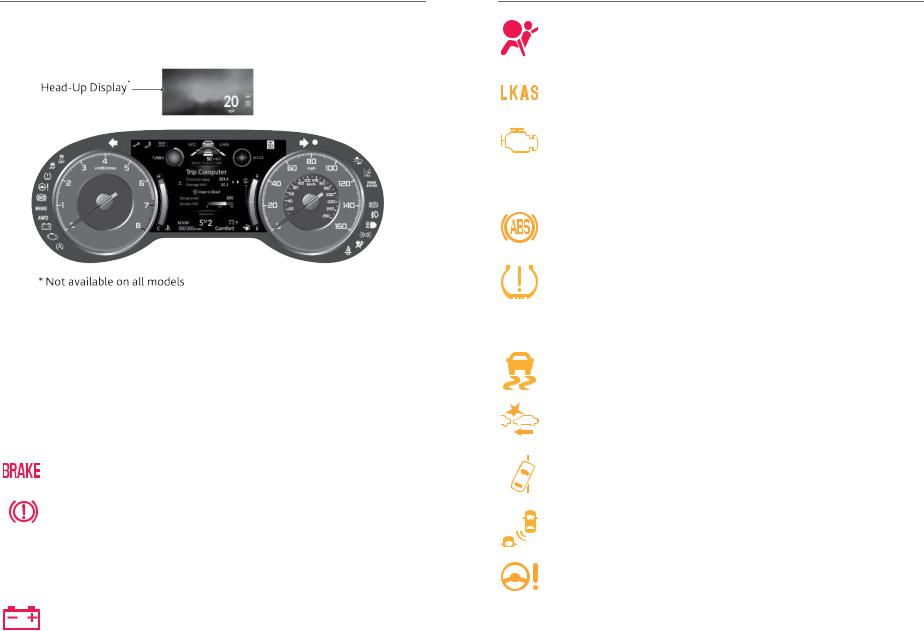
INSTRUMENT PANEL
INSTRUMENT PANEL
Indicators, gauges, and displays related to driving the vehicle.
Indicators briefly appear with each engine start and then go out. Red and amber indicators are most critical. Blue and green indicators are used for general information.
Malfunction Indicators
These are the most critical indicators. If they come on and stay lit while driving or at any other time, there may be a problem. See your dealer for assistance.
|
Brake system |
|
|
|
|
||
|
|
||
U.S. |
• |
Brake fluid is low. |
|
|
|||
|
|||
|
|||
|
|||
|
|||
|
• |
There is a malfunction in the brake system. |
|
Canada |
Press the brake pedal lightly to check pedal pressure. If normal, |
|
|
check the brake fluid level when you stop. If abnormal, take |
|
||
|
|
||
|
immediate action. If necessary, downshift the transmission to |
|
|
|
slow the vehicle using engine braking. Have your vehicle repaired |
|
|
|
immediately. |
|
|
12-Volt Battery Charging system
The 12-volt battery is not charging. Turn all electrical items off, but do not turn the vehicle off to prevent further battery discharge. Have your vehicle repaired immediately.
INSTRUMENT PANEL
Supplemental Restraint System (SRS)
There is a problem with one of the airbag systems or seat belt tensioners.
Lane Keeping Assist System (LKAS)
There is a problem with the system.
Malfunction Indication Lamp (check engine light)
The emissions control system may have a problem, or the fuel cap is missing or loose. If the indicator blinks, a misfire in the engine’s cylinders is detected. Stop in a safe place and wait for the engine to cool down.
Anti-lock Brake System (ABS)
There is a problem with the anti-lock brake system. Your vehicle still has normal braking ability, but no anti-lock function.
Low Tire Pressure / Tire Pressure Monitoring System (TPMS)
• Blinks and remains on:
Have your vehicle checked by a dealer. If the vehicle is fitted with a compact spare, get your regular tire repaired or replaced and put back on your vehicle as soon as you can.
Vehicle Stability Assist® (VSA®) System
There is a problem with the VSA® or hill start assist system.
Collision Mitigation Braking System™ (CMBS™)
There is a problem with the system, the temperature inside the camera is too high or the camera or sensor is blocked.
Road Departure Mitigation (RDM)
There is a problem with the system, the temperature inside the camera is too high, or the camera is blocked.
Blind Spot Information*1
There is a problem with the system, or the sensor is blocked.
Electric Power Steering (EPS)
There is a problem with the system. Stop the vehicle in a safe place, and restart the engine.
*1 - If equipped
26 | |
| 27 |
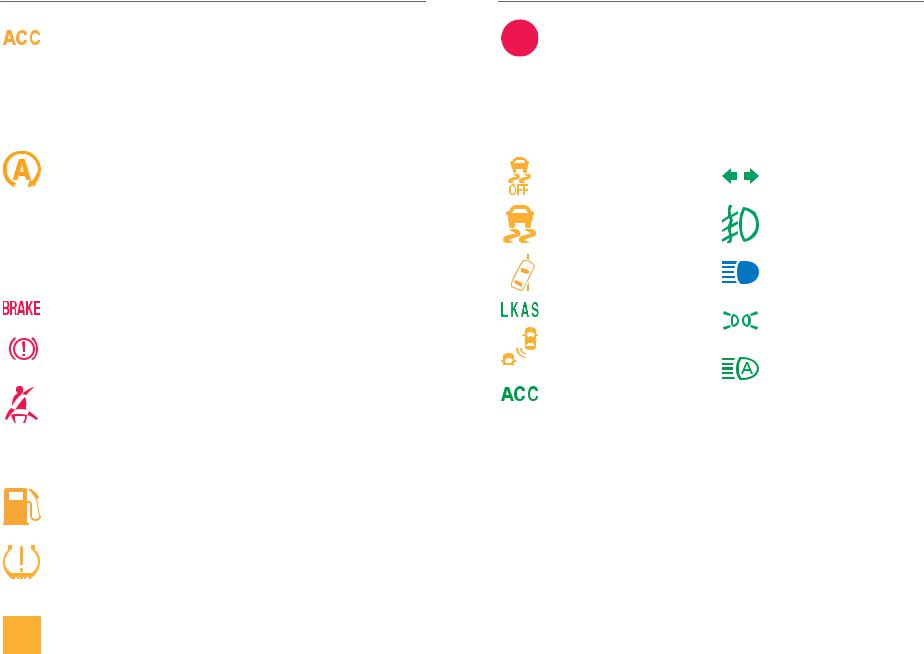
INSTRUMENT PANEL
Adaptive Cruise Control (ACC) with Low Speed Follow
There is a problem with the system.
•If the indicator stays on constantly, have your vehicle checked by a dealer.
•Indicator may come on temporarily when the Maximum Load Limit is exceeded.
Make sure the total load is within the Maximum Load Limit.
Auto Idle Stop
•Blinks if there is a problem with the Auto Idle Stop system. Have your vehicle checked by a dealer.
•Comes on when the Auto Idle Stop system has been turned off by the Auto Idle Stop system OFF button.
Condition Indicators
These indicators may require you to perform an action.
|
Parking Brake |
U.S. |
Release the parking brake before driving. You will hear a beep if |
|
you drive with it not fully released. |
Canada
Seat Belt Reminder
Make sure seat belts are fastened for you and all passengers. The indicator blinks and beeps sound continuously if you or your front passenger has not fastened your seat belts when you begin driving. If the indicator remains on after seat belts are fastened, see your dealer.
Low Fuel
Refuel as soon as possible. If the indicator blinks, there is a problem with the fuel gauge. See your dealer.
Low Tire Pressure / Tire Pressure Monitoring System (TPMS)
• Comes on while driving:
Stop in a safe place, check tire pressures, and inflate tire(s) if necessary.
System Message
When a condition or malfunction indicator comes on, a message also appears on the multi-information display (MID). Check the display for more information.
INSTRUMENT PANEL
Immobilizer
Your key or remote transmitter cannot be recognized by the vehicle. If the indicator blinks, you may not be able to start the engine. Turn the vehicle off, and then on again. If it continues to blink, there may be a problem with the system. See your dealer.
On/Off Indicators
These indicators remind you when an item is on or off.
|
VSA® off |
|
Turn signals/hazards on |
||
|
VSA® engaged (blinks) |
|
Fog lights*1 on |
||
|
RDM off |
|
High beams on |
||
|
|||||
|
|||||
|
|||||
|
LKAS on |
|
Exterior lights on |
||
|
|
||||
|
|
||||
|
|
||||
|
|
||||
|
|
||||
|
|
||||
|
|
|
|
|
|
|
Blind Spot Information*1 |
|
|
||
|
off |
|
Auto High Beam System on |
||
|
|
|
|
|
|
|
ACC on |
|
|
||
*1 - If equipped
28 | |
| 29 |
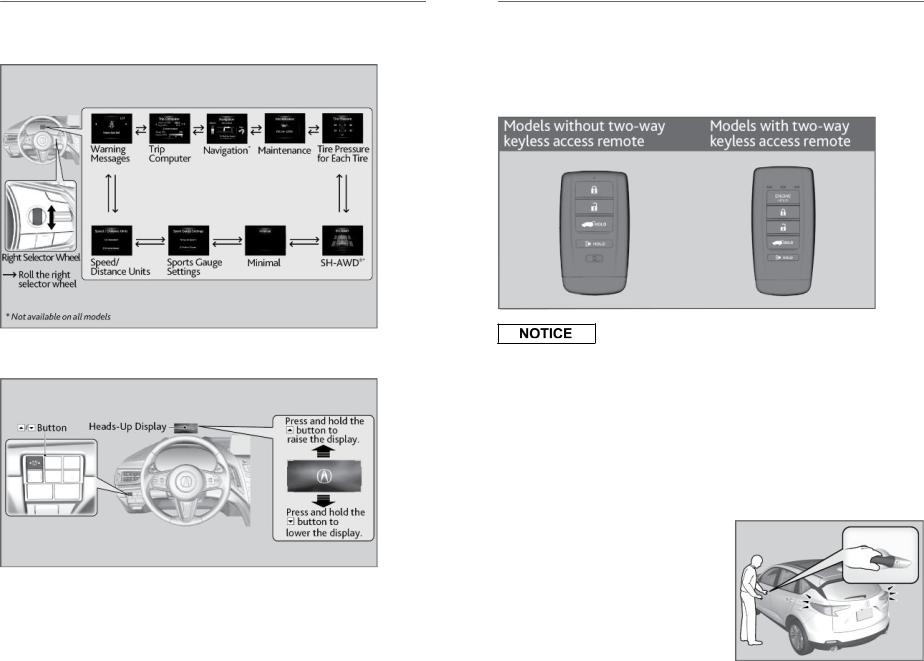
INSTRUMENT PANEL
Multi-Information Display
Head-Up Display*1
VEHICLE CONTROLS
VEHICLE CONTROLS
Various controls necessary for operating and driving the vehicle.
Using the Remote Transmitter
Lock or unlock the doors , fuel fill door, or tailgate.
Leaving the remote transmitter in the vehicle can result in theft or accidental movement of the vehicle. Always take it with you whenever you leave the vehicle unattended.
Keyless Access System
When you carry the remote transmitter, in a pocket or purse and it is outside the vehicle and within range (about 32 inches or 80 cm), you can lock or unlock the doors, fuel fill door, and open the tailgate without handling the transmitter.
nUnlocking/Locking the Doors
To unlock: Grab the driver’s door handle to unlock the driver’s door and
fuel fill door. Grab the front passenger’s door handle or rear *1 door handle to unlock all the doors, fuel fill door, and the tailgate. You can customize this feature’s behavior.
*1 - If equipped |
*1 - If equipped |
30 | |
| 31 |
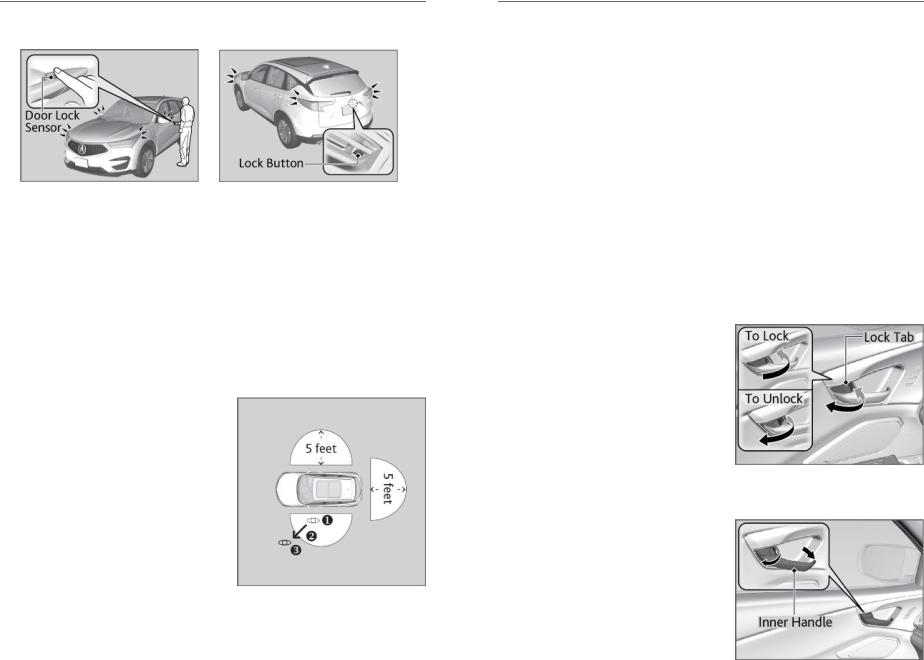
VEHICLE CONTROLS
To lock: Press the door lock button on a front door, rear*1 door, or the tailgate.
Note: System range is affected by radio signals from other devices (for example, cell phones or tablets) so for best results, carry the remote transmitter separately from these devices.
nWalk Away Auto Lock®
When you walk away from the vehicle while carrying the remote transmitter, the doors and tailgate can automatically lock if the following conditions are met:
•The remote transmitter is within a range of 5 feet (1.5 m).
•All doors and the tailgate are closed.
•There is not an additional remote transmitter inside the vehicle. Follow these steps:
1.Exit the vehicle, close the door and stay near it. Listen for a beep. The system is activated.
2.Walk at least 5 feet (1.5 m) away.
3.Listen for a beep and look for the lights to flash. The doors lock.
The auto lock function is set to OFF as the factory default setting. It can be set to ON using the If you set the auto lock function to ON, only the remote transmitter that was used to unlock the driver's door prior to the setting
change can activate auto lock. To turn on this feature, follow the steps below:
Using the Information Screen
1. From the HOME screen, select Settings.
*1 - If equipped
VEHICLE CONTROLS
2.Select Vehicle.
3.Select Keyless Access Setup.
4.Select Walk Away Auto Lock®, then select Enable.
nCustomizing Door Lock and Unlock Settings
Customize the auto door lock and door unlock settings to your preference. Begin with the vehicle off.
1.Select Home.
2.Select Settings.
3.Select Vehicle.
4.Select Door Setup.
5.Select Auto Door Lock or Auto Door Unlock then select an option.
Door Operation
There are three methods of unlocking the doors from inside the vehicle.
nUsing the Lock Tab
To unlock: When you unlock either front door using the lock tab, the specific door (driver’s or passenger’s) unlocks.
To lock: When you lock the door using the lock tab on the driver’s door, all the other doors and the tailgate lock at the same time. When you lock the door using the lock tab on the front passenger’s door, only that door locks.
nUsing the Front Door Inner Handle
Pull the front door inner handle. The door unlocks and opens in one motion. Unlocking and opening the driver’s door from the inner handle unlocks all other doors.
Do not pull a front door inner handle while the vehicle is moving.
32 | |
| 33 |
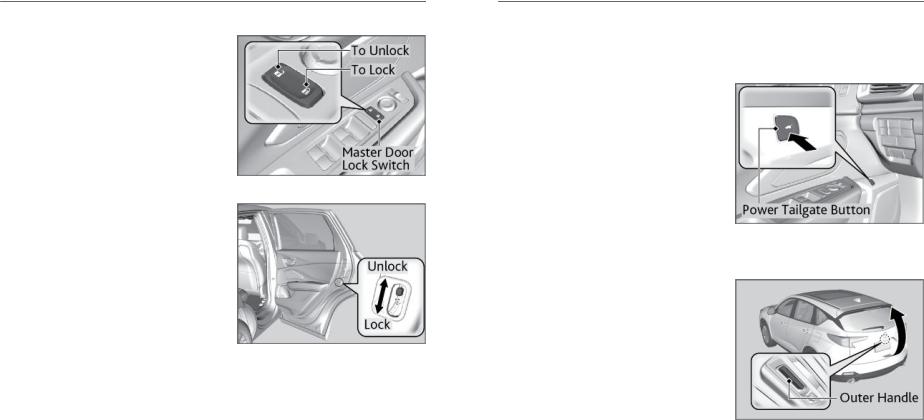
VEHICLE CONTROLS
nUsing the Master Door Lock Switch
To unlock: Press the unlock side of the switch to unlock all doors and the tailgate.
To lock: Press the lock side of the switch to lock all doors and the tailgate.
nChildproof Door Locks
The childproof door locks prevent the rear doors from being opened from the inside regardless of the position of the lock tab.
Slide the lever in the rear door to the lock position, and close the door.
Open the door using the outer door handle.
Note: To open the door from the inside
when the childproof door lock is on, put the lock tab in the unlock position, lower the rear window, put your hand out of the window, and pull the outside door handle.
VEHICLE CONTROLS
Tailgate Operation
Use these methods to operate the tailgate.
nPower Tailgate Button
To open or close the power tailgate, press the power tailgate button for about one second.
If you press the button again while the power tailgate is moving, it will stop. Press the button for about one second, and the power tailgate will reverse direction.
nPower Tailgate Outer Handle Automatic Operation
If you press the outer handle of the tailgate for no longer than one second, the tailgate opens automatically.
Manual Operation
If you want to open the tailgate manually, press the button for more than one second.
nProgrammable Tailgate Position
You can set the maximum opening of the tailgate to suit your needs.
1.Manually adjust the tailgate to your desired position.
2.Press and hold the tailgate inner button until you hear one long and two short beeps.
34 | |
| 35 |

VEHICLE CONTROLS
nPower Tailgate Inner Button
Press the button on the tailgate to close the power tailgate.
If you press the button again while the power tailgate is moving, it will stop. Press and release the button again, and the power tailgate will reverse direction.
nHands-Free Access Power Tailgate*1
Use a forward and back kicking motion under the center of the rear bumper to open or close the power tailgate while carrying the smart entry remote. Some exterior lights flash twice and a beeper sounds once, then the tailgate begins to move.
Note: This function will not operate if you don't have the smart entry remote
on you. Please make sure you have the smart entry remote on you.
During rain or in other instances when the vehicle becomes wet, the sensor may not properly detect your foot motion.
Closing a power tailgate while anyone is in the path of the tailgate can cause serious injury.
Make sure everyone is clear before closing the power tailgate.
Power Window Operation
Power windows can be opened and closed by using the switches on the doors when the vehicle is on. The switches on the driver’s side can be used to open and close all the windows.
nAutomatic Operation
To open: Push the switch down firmly. To close: Pull the switch up firmly.
The window opens or closes completely. To stop the window at any time, push or pull the switch again briefly.
*1 - If equipped
VEHICLE CONTROLS
nManual Operation
To open: Push the switch down lightly. To close: Pull the switch up lightly.
Release the switch when the windows reach the desired position.
nPower Window Lock
Push in the power window lock button so only the driver’s window can be operated.
Closing a power window on someone’s hands or fingers can cause serious injury.
Make sure your passengers are away from the windows before closing them.
Panoramic Roof
You can only operate the panoramic roof when the power mode is ON. Use the switch in the front of the ceiling to open and close the panoramic roof.
Opening or closing the panoramic roof on someone's hands or fingers can cause serious injury.
Make sure all hands and fingers are clear of the panoramic roof before opening or closing it.
36 | |
| 37 |
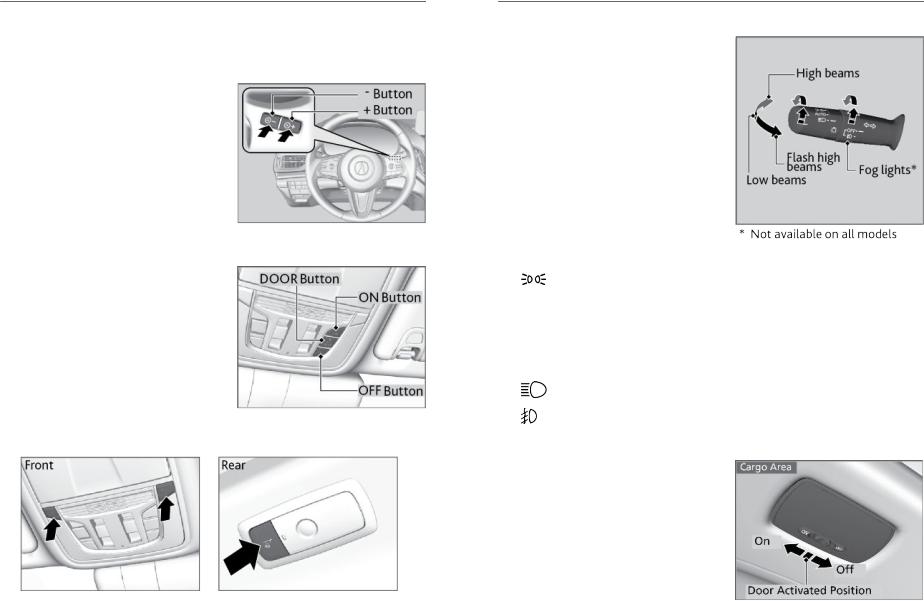
VEHICLE CONTROLS
Interior and Exterior Lights
Operate interior and exterior lights when the vehicle is on or off.
nBrightness Control
Adjust instrument panel brightness when the vehicle is on.
To brighten: Press the + button. To dim: Press the - button.
A beep sounds when the brightness reaches its minimum or maximum.
nInterior Lights
Change the interior light settings using the switches on the ceiling.
ON position: Interior lights remain on.
Door-activated position: Interior lights come on when any of the doors are opened, the driver’s door is unlocked, or the vehicle is turned off.
OFF position: Interior lights remain off.
nMap Lights
Press the map lights to turn on or off.
VEHICLE CONTROLS
nExterior Lights
Rotate the switches on the lever to operate the exterior lights.
Push the lever forward to turn on the high beams.
Return the lever to its original position for low beams.
OFF: All exterior lights are off.
Turn on exterior lights except headlights.
AUTO: Turn on the automatic lighting feature. Headlights turn on or off depending on ambient brightness when the vehicle is on. Headlights automatically come on after the wipers are engaged for a certain time. The headlights come on when you unlock a door in dark areas with the headlight switch in AUTO.
Turn on all exterior lights including headlights.
Turn fog lights*1 on or off.
nCargo Area Lights
Located on the rear ceiling in front of the tailgate.
Tailgate activated: The light comes on when you open the tailgate, and goes off when closed.
*1 - If equipped
38 | |
| 39 |

VEHICLE CONTROLS
One-Touch Turn Signal
Use this quick and convenient method to signal a lane change.
Lightly push the turn signal lever up or down for an automatic three-blink sequence.
For a continuous signal, push the lever up or down until it locks into place.
40 |
VEHICLE CONTROLS
Auto High Beam
The front sensor camera detects the light sources ahead of the vehicle such as the lights of a preceding or oncoming vehicle, or street lights. When you are driving at night, the system automatically switches the headlights between low beam and high beam depending on the situation.
For the system to work properly:
•Do not place an object that reflects light on the dashboard.
•Keep the windshield around the camera clean. When cleaning the windshield, be careful not to apply windshield cleanser to the camera lens.
•Do not attach an object, sticker or film in the area around the camera.
•Do not touch the camera lens.
If the camera receives a strong impact or requires repair, consult a dealer.
If you see the message “Some Driver Assist Systems Cannot Operate: Clean Front Windshield", park your vehicle in a safe place. Wipe away debris blocking the windshield, then start driving again. If the message remains even after driving for a while with the clean windshield, have your vehicle checked by a dealer.
If you see a message that the camera is too hot, use the climate control system to cool the interior. Defroster mode will direct airflow toward the camera.
nAutomatically switching between high beam and low beam
When auto high beam is active, the headlights switch between high beam and low beam based on the following conditions.
If you find the timing of beam changes inconvenient for driving, change the beams manually.
Switching to high beam
All of the following conditions must be met before the high beams turn on.
| 41
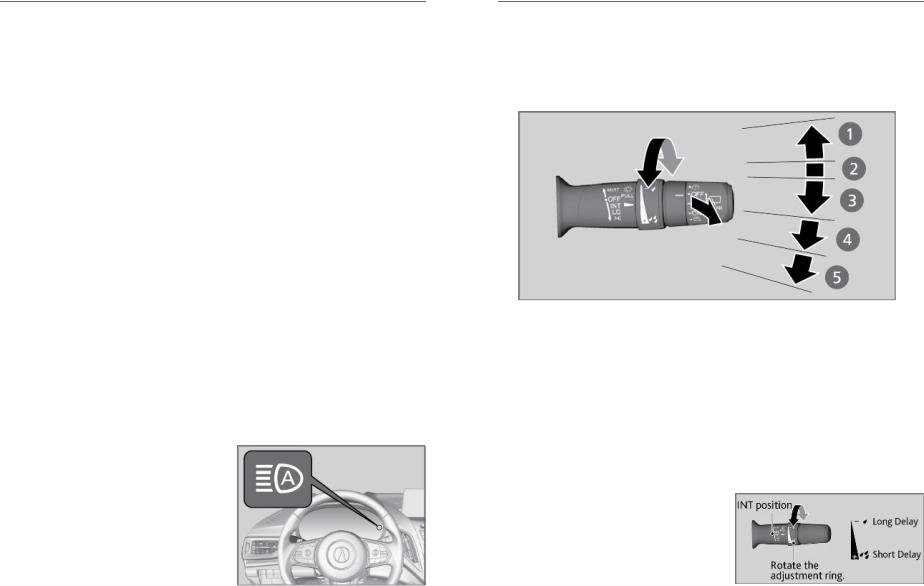
VEHICLE CONTROLS
•Your vehicle speed is 25 mph (40 km/h) or more.
•There are no preceding or oncoming vehicle with headlights or taillights turned on.
•There are few street lights on the road ahead.
Switching to low beam
One of the following conditions must be met before the low beams turn on.
•Your vehicle speed is 15 mph (24 km/h) or less.
•There is a preceding or oncoming vehicle with headlights or taillights turned on.
•There are many street lights on the road ahead.
n Manually switching between high beam and low beam
Using the Pull the lever toward you for flashing the high beams then lever: release it within about one second while driving.
To reactivate, pull the lever toward you for flashing the high beams then release it while driving. The auto high beam indicator will come on.
Using the Turn the light switch to  .
.
light To reactivate, turn the light switch to AUTO when the lever switch: is in the low beam position, the auto high beam indicator will
come on.
nTurning the System On or Off
Make sure the headlight lever is in the low beam position with the switch rotated to the AUTO position. The auto high beam system indicator comes on.
To turn the system Pull and hold the headlight lever toward you for on: about 30 seconds, until the indicator flashes once.
To turn the system Pull and hold the headlight lever toward you for off: about 40 seconds, until the indicator flashes twice.
VEHICLE CONTROLS
Wiper Operation
The windshield wipers and washers can be used when the vehicle is on.
nFront Wipers
Move the wiper lever up or down to the desired position.
1. |
MIST |
4. |
LO: Low speed wipe |
2. |
OFF |
5. |
HI: High speed wipe |
3. |
INT*1/AUTO*1 |
|
|
nHeadlight Integration with Wipers
When the headlights are in the AUTO position, they automatically turn on when the front wipers operate several times within a certain interval. The headlights turn off shortly after the wipers are turned off or if there is enough ambient light.
nIntermittent (INT) Wipers
When you move the lever to the INT position, the wipers operate based on the delay adjustment.
Rotate the adjustment ring to adjust the wiper delay.
*1 - If equipped
42 | |
| 43 |
